94. Hypospadias - Global HELP
94. Hypospadias - Global HELP
94. Hypospadias - Global HELP
You also want an ePaper? Increase the reach of your titles
YUMPU automatically turns print PDFs into web optimized ePapers that Google loves.
<strong>Hypospadias</strong> 543<br />
• <strong>Hypospadias</strong> with corporeal disproportion: This condition is rather<br />
rare. The situation is encountered when the ventral tunica albuginea<br />
surrounding the corpora cavernosa is also contracted. Excision of the<br />
disorganised fascial tissue distal to the meatus is not enough to achieve<br />
a straight penis. This condition is thought to be encountered mainly in<br />
older children with long-standing uncorrected proximal hypospadias.<br />
Source: Hadidi AT, Azmy AF, eds. <strong>Hypospadias</strong> Surgery: An Illustrated Guide, 1st ed. Springer<br />
Verlag, 2004. Reproduced with kind permission of Springer Verlag.<br />
Figure <strong>94.</strong>3: Superficial chordee.<br />
Source: Hadidi AT, Azmy AF, eds. <strong>Hypospadias</strong> Surgery: An Illustrated Guide, 1st ed. Springer<br />
Verlag, 2004. Reproduced with kind permission of Springer Verlag.<br />
Figure <strong>94.</strong>4: Deep chordee. Deep chordee is usually associated with proximal<br />
hypospadias. Incision of the urethral plate at the coronal sulcus will increase<br />
the distance between the tip of the penis (A) and the urethral meatus (B). The<br />
distance between the urethral meatus (B) and the penoscrotal junction (C)<br />
remains constant.<br />
Source: Hadidi AT, Azmy AF, eds. <strong>Hypospadias</strong> Surgery: An Illustrated Guide, 1st ed. Springer<br />
Verlag, 2004. Reproduced with kind permission of Springer Verlag.<br />
Figure <strong>94.</strong>5: Prepuce in hypospadias.<br />
The Prepuce<br />
The prepuce presents in several variations in hypospadias. In the majority<br />
of patients, the prepuce is longer than normal dorsally but absent<br />
ventrally. There are two lateral edges that are fixed at the lateral borders<br />
of the ventral aspect of the prepuce. Thus, the prepuce is deficient ventrally.<br />
To get an idea about the area of underdevelopment of the urethra<br />
and corpus spongiosum , draw two lines along the two lateral edges of<br />
the prepuce.<br />
A common finding in many hypospadias patients is two rounded<br />
knobs laterally on the dorsum of the prepuce (like two little eyes, whirls,<br />
or dog-ears) (Figure <strong>94.</strong>5). The significance of these two knobs is still<br />
unclear. These two little knobs are visible on the prepuce after preputial<br />
reconstruction following hypospadias repair. Attempts to excise the two<br />
knobs during the prepuce reconstruction usually results in a very short<br />
prepuce, and it is important to inform the parents of this beforehand.<br />
The prepuce itself may accentuate the degree of penile chordee. In<br />
many cases, the family doctor reports the presence of penile chordee<br />
because of the hooded appearance of the prepuce and the presence of a<br />
peculiar line of cleavage.<br />
In less than 5% of hypospadias patients, the prepuce is complete,<br />
covers the whole glans and is longer than normal. This may result in late<br />
diagnosis of hypospadias and excision of the prepuce wrongly in routine<br />
circumcision. This is considered as a separate entitiy and is called “hidden<br />
hypospadias” or mega-meatus intact prepuce (MIP) hypospadias.<br />
The Urethral Plate<br />
The urethral plate is a pink gutter of mucous membrane with a welldefined<br />
mucocutaneous line. This gutter may extend from the hypospadiac<br />
urethral orifice to the base of the glans penis. Rarely, it may extend<br />
well into the glans.<br />
Paul and Kanagasuntheram have described the histological sections<br />
of this gutter to be stratified squamous epithelium with pigment in the<br />
malpighian layer. 23 These sections show no underlying layer of erectile<br />
tissue. In patients with perineal hypospadias, histology of sections<br />
within the scrotum showed pseudostratified columner epithelium rather<br />
than transitional epithelium. There is no erectile tissue.<br />
The Penile Raphe<br />
The penile raphe is normally situated in the ventral midline. In hypospadias,<br />
it is usually present (85%) and bifurcates proximal to the<br />
hypospadiac meatus into two branches that end distally into what is<br />
called eyes, whirls, or dog-ears (Figure <strong>94.</strong>5). The area between the two<br />
branches of the raphe gives an idea of the extent of the developmental<br />
defect of the corpus spongiosum and ventral fascia.<br />
Size of the Penis<br />
The size of the penis is normal in the majority of hypospadias patients.<br />
Patients with disorders of sex development constitute a different category.<br />
Avellán has found penile hypoplasia in 3% of his patients, half<br />
of which had associated chromosomal anomalies. 24<br />
The Proximal Urethra<br />
The proximal urethra may be very thin for a variable distance down to<br />
the perineum. This is probably due to the absence of corpus spongiosum<br />
to a variable degree. Incomplete urethral valves may be present<br />
and render the introduction of an intraurethral catheter difficult.<br />
In some patients with hypospadias, there may be accessory blind<br />
paraurethral tracts that open at the same urethral opening and end<br />
blindly after 1–2 cm. Classic posterior urethral valves may be present<br />
in about 10% of patients with hypospadias


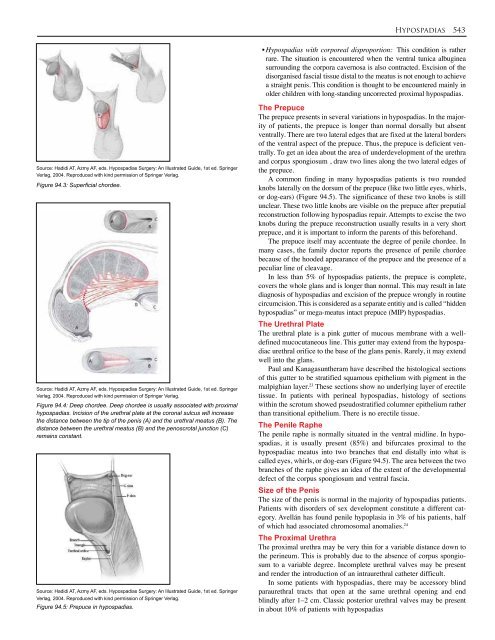

![Clubfoot: Ponseti Management [Vietnamese] - Global HELP](https://img.yumpu.com/51276842/1/184x260/clubfoot-ponseti-management-vietnamese-global-help.jpg?quality=85)
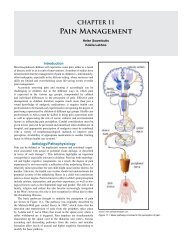

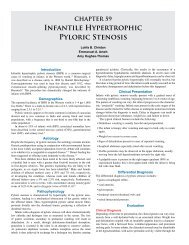
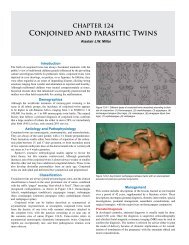

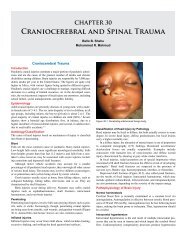

![Steenbeek Brace For Clubfoot [2nd Edition] - Global HELP](https://img.yumpu.com/46612972/1/190x245/steenbeek-brace-for-clubfoot-2nd-edition-global-help.jpg?quality=85)

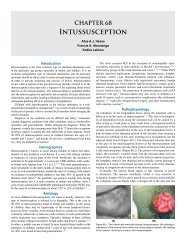

![Basics Of Wound Care [Indonesia] - Global HELP](https://img.yumpu.com/41566370/1/190x245/basics-of-wound-care-indonesia-global-help.jpg?quality=85)
